Uncovering the Secrets of Trusses: A Structural Marvel
Trusses are fascinating structures that play a crucial role in the world of engineering and construction. These skeletal frameworks are designed to provide stability, strength, and support for a variety of architectural ventures. From bridges to buildings, trusses are the unsung heroes that allow structures to withstand immense loads and forces. In this article, we will delve into the secrets of trusses, uncovering their remarkable features and shedding light on their importance in the world of structural engineering.
The Basics of Trusses
Trusses are essentially assemblies of triangular units connected at their joints. This triangular arrangement is what gives trusses their incredible strength and stability. By distributing the force applied to the structure evenly, trusses can efficiently bear heavy loads, making them ideal for a wide range of applications.
One of the key advantages of trusses is their ability to span long distances without the need for additional support columns or walls. This makes them particularly suitable for creating open and airy spaces, allowing architects to achieve their design goals while maintaining structural integrity.
Trusses come in various forms, each designed to suit specific needs and requirements. Some common types include:
- King Post Truss
- Queen Post Truss
- Howe Truss
- Scissor Truss
- Warren Truss
Each type has its own unique configuration and characteristics, allowing engineers to choose the most suitable truss for a particular project.
The Secrets Behind Truss Strength
The strength of trusses lies in their triangular shape. The triangular units, or truss members, work together to distribute the applied forces along their axes. This distribution prevents any individual member from bearing an excessive load, ensuring the overall stability and strength of the structure.
Additionally, trusses are designed to minimize bending and flexing, which can lead to structural failure. By carefully calculating the angles and lengths of the truss members, engineers can create a framework that can withstand various loads and forces, such as those caused by wind, snow, or seismic activity.
Furthermore, trusses often incorporate additional elements, such as struts and braces, to enhance their stability. These elements provide extra support and help to minimize any potential movement or deformation of the truss under load, ensuring the long-term integrity of the structure.
Applications of Trusses
The versatility of trusses allows them to be used in a wide array of architectural and engineering projects. Some notable applications include:
Bridges
Trusses are commonly employed in bridge construction due to their ability to span long distances. Whether it’s a pedestrian bridge or a massive highway overpass, trusses provide the necessary support and stability to ensure the safety of the structure and its users.
Roofing Systems
Trusses are widely used in roofing systems for residential, commercial, and industrial buildings. By utilizing trusses, architects and engineers can create large, open spaces without the need for interior load-bearing walls or columns. This design flexibility allows for efficient use of space and enables diverse architectural possibilities.
Industrial Structures
Trusses find extensive use in industrial structures, such as warehouses, factories, and arenas, where large clear spans are required. The ability of trusses to support heavy loads and resist dynamic forces makes them an ideal choice for such applications.
Frequently Asked Questions
1. Can trusses be customized to fit specific project requirements?
Yes, trusses can be customized to fit the specific needs of a project. Engineers consider factors such as load requirements, span length, architectural constraints, and aesthetic preferences to design trusses that best suit the intended purpose.
2. How long do trusses typically last?
The lifespan of trusses depends on various factors, including the materials used, environmental conditions, and maintenance practices. However, with proper care and regular inspections, trusses can last for several decades.
3. Are trusses more expensive than traditional building methods?
The cost of trusses can vary depending on the complexity of the design, span length, and materials used. In some cases, trusses may be more cost-effective compared to traditional building methods, especially when considering the long-term benefits they bring, such as increased usable space and reduced need for interior support.
4. Can trusses be used in both residential and commercial construction?
Absolutely! Trusses are widely used in both residential and commercial construction. Whether it’s a single-family home, a high-rise apartment building, or a shopping mall, trusses offer structural stability and design flexibility for a variety of construction projects.
5. How do trusses contribute to sustainable building practices?
Trusses contribute to sustainable building practices by minimizing the use of materials and maximizing the efficient use of space. Their lightweight nature reduces the overall carbon footprint of a structure while providing strength and stability. Additionally, trusses can accommodate insulation materials, allowing for better energy efficiency in buildings.
For more information on trusses and their applications, you can visit this article or explore this resource.






